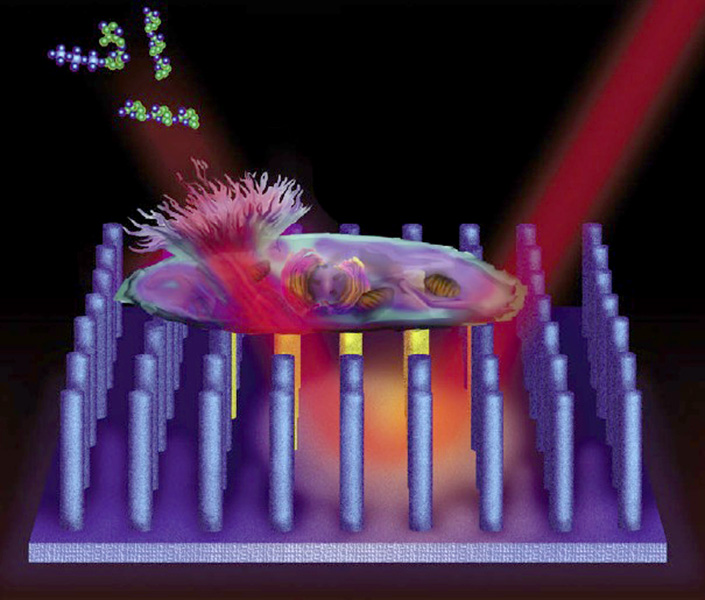One in a Million: Analyzing Metabolites in a Single Cell
Commercialized nanopost array platform reveals metabolic changes in individual cells due to environmental stress.

The Science
Based on interactions between silicon nanopost arrays (NAPA) and laser light, an ionization platform was developed for the ultrasensitive detection of molecules. With detection limits down to the zeptomolar range (a thousand trillionth of a mole, or about 600 molecules in a sample), this technology can analyze the metabolic composition of individual microbial cells, as well as detect the presence of extremely low levels of contaminants in the environment.
The Impact
Using the array, scientists can detect and measure trace levels of small molecules via existing scientific platforms without matrix effects that mask small quantities of molecules. Scientists can use the NAPA to determine changes in cellular metabolite level distributions and metabolic noise upon environmental stress, analyze trace contaminants in liquids, and image molecular distributions in tissues. The NAPA invention was licensed by Protea Biosciences Group, Inc., and commercialized under the REDIchip™ name in June 2015.
Summary
Cells produce and consume varying amounts of metabolites in the course of their regular functioning. To maintain homeostasis or a relatively stable state under changing environmental conditions, cell populations respond by changing the distributions of their metabolite levels. Ideally, investigators would like to observe these responses for a single cell during both stable and stressed states; however, matrix-assisted laser desorption ionization (MALDI) mass spectrometry techniques suffer from matrix-associated background problems that prevent the detection of small molecules at individual cell levels. Researchers at the George Washington University, working in collaboration with the Center for Nanophase Materials Sciences at the Oak Ridge National Laboratory, have developed NAPA substrates that can be used for matrix-free mass spectrometry analysis and imaging. The NAPA platform consists of an array of silicon nanoposts that exhibit enhanced electromagnetic fields upon interaction with pulses of laser radiation. This process causes the ionization of cellular molecules without the hassle of a matrix. Using NAPA mass spectrometry, the research group has determined the metabolic response of individual yeast cells to oxidative stress. Additionally, the NAPA platform has shown the capabilities to analyze a wide variety of biomolecules and xenobiotics in a broad class of samples, making it the foundation for matrix-free laser desorption ionization. Protea Biosciences Group, Inc. exclusively licensed the NAPA platform; in June 2015, the company commercialized the platform under the name of REDIchip™.
Contact
Professor Akos Vertes
George Washington University, Washington DC
vertes@gwu.edu
(202) 994-2717
Funding
Part of this research (fundamental studies) was supported by the U.S. Department of Energy, Office of Science, Office of Basic Energy Sciences, Chemical Sciences, Geosciences, and Biosciences Division under Award # DE-FG02-01ER15129. Nanofabrication was conducted at the Center for Nanophase Materials Sciences, which is sponsored at the Oak Ridge National Laboratory by the Scientific User Facilities Division, Office of Basic Energy Sciences, Office of Science, U.S. Department of Energy. Other parts of the research (commercialization) were sponsored by the U.S. Army Research Office and the Defense Advanced Research Projects Agency and were accomplished under Cooperative Agreement Number W911NF-14-2-0020.
Publications
B. N. Walker, C. Antonakos, S. T. Retterer, and A. Vertes, “Metabolic differences in microbial cell populations revealed by nanophotonic ionization.” Angewandte Chemie International Edition 52, 3650 (2013). [DOI: 10.1002/anie.201207348]
B. N. Walker, J. A. Stolee, and A. Vertes, “Nanophotonic ionization for ultratrace and single-cell analysis by mass spectrometry.” Analytical Chemistry 84, 7756 (2012). [DOI: 10.1021/ac301238k]
J. A. Stolee, B. N. Walker, V. Zorba, R. E. Russo, and A. Vertes, “'Laser-nanostructure interactions for ion production.” Physical Chemistry Chemical Physics 14, 8453 (2012). [DOI: 10.1039/C2CP00038E]
Related Links
The commercial version of NAPA at Protea Biosciences
Protea announces new mass spectrometry technology
Highlight Categories
Performer: University , Industry , SC User Facilities , BES User Facilities , CNMS
Additional: Technology Impact



